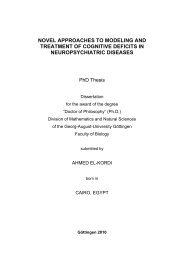Cortical and subcortical mechanisms in persistent stuttering ...
Cortical and subcortical mechanisms in persistent stuttering ...
Cortical and subcortical mechanisms in persistent stuttering ...
You also want an ePaper? Increase the reach of your titles
YUMPU automatically turns print PDFs into web optimized ePapers that Google loves.
Chapter 1 Scope of the dissertation<br />
1.6 Scope of the dissertation<br />
The objective of this dissertation is to explore cortical <strong>and</strong> <strong>subcortical</strong> <strong>mechanisms</strong> <strong>in</strong><br />
stutter<strong>in</strong>g.<br />
In the first study, repetitive transcranial magnetic stimulation (rTMS) helped discover<strong>in</strong>g a<br />
dysfunction of the left dorsolateral premotor cortex <strong>in</strong> control of paced f<strong>in</strong>ger movements <strong>and</strong><br />
a compensatory role of its right hemispheric homologue <strong>in</strong> stutter<strong>in</strong>g. While previous<br />
neuroimag<strong>in</strong>g studies elucidated altered activation patterns, we were able to directly show for<br />
the first time that the right hemisphere might <strong>in</strong>deed play a compensatory rather than<br />
maladaptive role for non-speech functions <strong>in</strong> <strong>persistent</strong> developmental stutter<strong>in</strong>g.<br />
In the second study, we aimed at detect<strong>in</strong>g neurophysiological changes <strong>in</strong> the primary motor<br />
tongue representation of the left <strong>and</strong> right hemisphere <strong>in</strong> adults with <strong>persistent</strong> stutter<strong>in</strong>g.<br />
Overcom<strong>in</strong>g methodological challenges of transcranial magnetic stimulation at orofacial<br />
structures, this is the first study demonstrat<strong>in</strong>g an abnormality <strong>in</strong> <strong>in</strong>tracortical excitability <strong>in</strong><br />
<strong>persistent</strong> stutter<strong>in</strong>g.<br />
The third study operationalized a behavioral approach to elucidate a possible disconnection<br />
between parieto-temporal regions <strong>in</strong>volved <strong>in</strong> the phonological bottom up process<strong>in</strong>g of<br />
speech stimuli <strong>and</strong> frontal regions ma<strong>in</strong>ly <strong>in</strong>volved <strong>in</strong> the plann<strong>in</strong>g, programm<strong>in</strong>g <strong>and</strong><br />
execution of speech movements. Behavioral deviations on a subcl<strong>in</strong>ical level might <strong>in</strong>dicate a<br />
disturbed functional connectivity of these ma<strong>in</strong> networks of speech process<strong>in</strong>g.<br />
The follow<strong>in</strong>g studies aim particularly:<br />
(1) to test the lateralization of cortical control of paced f<strong>in</strong>ger movement tim<strong>in</strong>g <strong>in</strong> stutter<strong>in</strong>g<br />
(2) to detect neurophysiological changes <strong>in</strong> the <strong>in</strong>tracortical excitability <strong>in</strong> the primary motor<br />
tongue representation of the left <strong>and</strong> right hemisphere by employ<strong>in</strong>g s<strong>in</strong>gle-pulse <strong>and</strong><br />
paired-pulse TMS <strong>in</strong> adults who stutter <strong>and</strong> matched control subjects<br />
(3) to test the stability of phoneme percepts <strong>in</strong> stutter<strong>in</strong>g by analyz<strong>in</strong>g participants’ sensitivity<br />
to identify voiced <strong>and</strong> voiceless stop-consonants near the phoneme boundary.<br />
27



